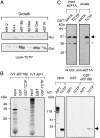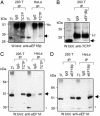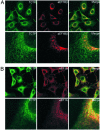Translationally controlled tumor protein acts as a guanine nucleotide dissociation inhibitor on the translation elongation factor eEF1A
- PMID: 14623968
- PMCID: PMC283517
- DOI: 10.1073/pnas.2335950100
Translationally controlled tumor protein acts as a guanine nucleotide dissociation inhibitor on the translation elongation factor eEF1A
Abstract
Recently, we demonstrated that the expression levels of the translationally controlled tumor protein (TCTP) were strongly down-regulated at the mRNA and protein levels during tumor reversion/suppression and by the activation of p53 and Siah-1. To better characterize the function of TCTP, a yeast two-hybrid hunt was performed. Subsequent analysis identified the translation elongation factor, eEF1A, and its guanine nucleotide exchange factor, eEF1Bbeta, as TCTP-interacting partners. In vitro and in vivo studies confirmed that TCTP bound specifically eEF1Bbeta and eEF1A. Additionally, MS analysis also identified eEF1A as a TCTP interactor. Because eEF1A is a GTPase, we investigated the role of TCTP on the nucleotide exchange reaction of eEF1A. Our results show that TCTP preferentially stabilized the GDP form of eEF1A, and, furthermore, impaired the GDP exchange reaction promoted by eEF1Bbeta. These data suggest that TCTP has guanine nucleotide dissociation inhibitor activity, and, moreover, implicate TCTP in the elongation step of protein synthesis.
Figures





Similar articles
-
Guanine nucleotides regulate sphingosine kinase 1 activation by eukaryotic elongation factor 1A and provide a mechanism for eEF1A-associated oncogenesis.Oncogene. 2011 Jan 20;30(3):372-8. doi: 10.1038/onc.2010.420. Epub 2010 Sep 13. Oncogene. 2011. PMID: 20838377
-
Plant Translation Elongation Factor 1Bβ Facilitates Potato Virus X (PVX) Infection and Interacts with PVX Triple Gene Block Protein 1.PLoS One. 2015 May 28;10(5):e0128014. doi: 10.1371/journal.pone.0128014. eCollection 2015. PLoS One. 2015. PMID: 26020533 Free PMC article.
-
Mutation of a conserved CDK site converts a metazoan Elongation Factor 1Bbeta subunit into a replacement for yeast eEF1Balpha.Mol Genet Genomics. 2003 Sep;269(6):776-88. doi: 10.1007/s00438-003-0888-1. Epub 2003 Jul 30. Mol Genet Genomics. 2003. PMID: 12898219
-
[Functional compartmentation of the translation apparatus and channeling of tRNA/aminoacyl-tRNA in cells of higher eukaryotes].Mol Biol (Mosk). 2001 Jul-Aug;35(4):702-7. Mol Biol (Mosk). 2001. PMID: 11524957 Review. Russian.
-
TPT1/ TCTP-regulated pathways in phenotypic reprogramming.Trends Cell Biol. 2013 Jan;23(1):37-46. doi: 10.1016/j.tcb.2012.10.002. Epub 2012 Oct 30. Trends Cell Biol. 2013. PMID: 23122550 Review.
Cited by
-
Tobacco Translationally Controlled Tumor Protein Interacts with Ethylene Receptor Tobacco Histidine Kinase1 and Enhances Plant Growth through Promotion of Cell Proliferation.Plant Physiol. 2015 Sep;169(1):96-114. doi: 10.1104/pp.15.00355. Epub 2015 May 4. Plant Physiol. 2015. PMID: 25941315 Free PMC article.
-
A proteomic study on molecular mechanism of poor grain-filling of rice (Oryza sativa L.) inferior spikelets.PLoS One. 2014 Feb 21;9(2):e89140. doi: 10.1371/journal.pone.0089140. eCollection 2014. PLoS One. 2014. PMID: 24586550 Free PMC article.
-
Translationally controlled tumor protein is a novel biological target for neurofibromatosis type 1-associated tumors.J Biol Chem. 2014 Sep 19;289(38):26314-26326. doi: 10.1074/jbc.M114.568253. Epub 2014 Aug 4. J Biol Chem. 2014. PMID: 25092287 Free PMC article.
-
TCTP overexpression is associated with the development and progression of glioma.Tumour Biol. 2013 Dec;34(6):3357-61. doi: 10.1007/s13277-013-0906-9. Epub 2013 Jun 9. Tumour Biol. 2013. PMID: 23749504
-
Biological effects of Mammalian translationally controlled tumor protein (TCTP) on cell death, proliferation, and tumorigenesis.Biochem Res Int. 2012;2012:204960. doi: 10.1155/2012/204960. Epub 2012 May 22. Biochem Res Int. 2012. PMID: 22675633 Free PMC article.
References
-
- Bohm, H., Benndorf, R., Gaestel, M., Gross, B., Nurnberg, P., Kraft, R., Otto, A. & Bielka, H. (1989) Biochem. Int. 19, 277–286. - PubMed
-
- Bohm, H., Gross, B., Gaestel, M., Bommer, U. A., Ryffel, G. & Bielka, H. (1991) Biomed. Biochim. Acta 50, 1193–1203. - PubMed
-
- Gachet, Y., Tournier, S., Lee, M., Lazaris-Karatzas, A., Poulton, T. & Bommer, U. A. (1999) J. Cell Sci. 112, 1257–1271. - PubMed
MeSH terms
Substances
LinkOut - more resources
Full Text Sources
Other Literature Sources
Research Materials
Miscellaneous

